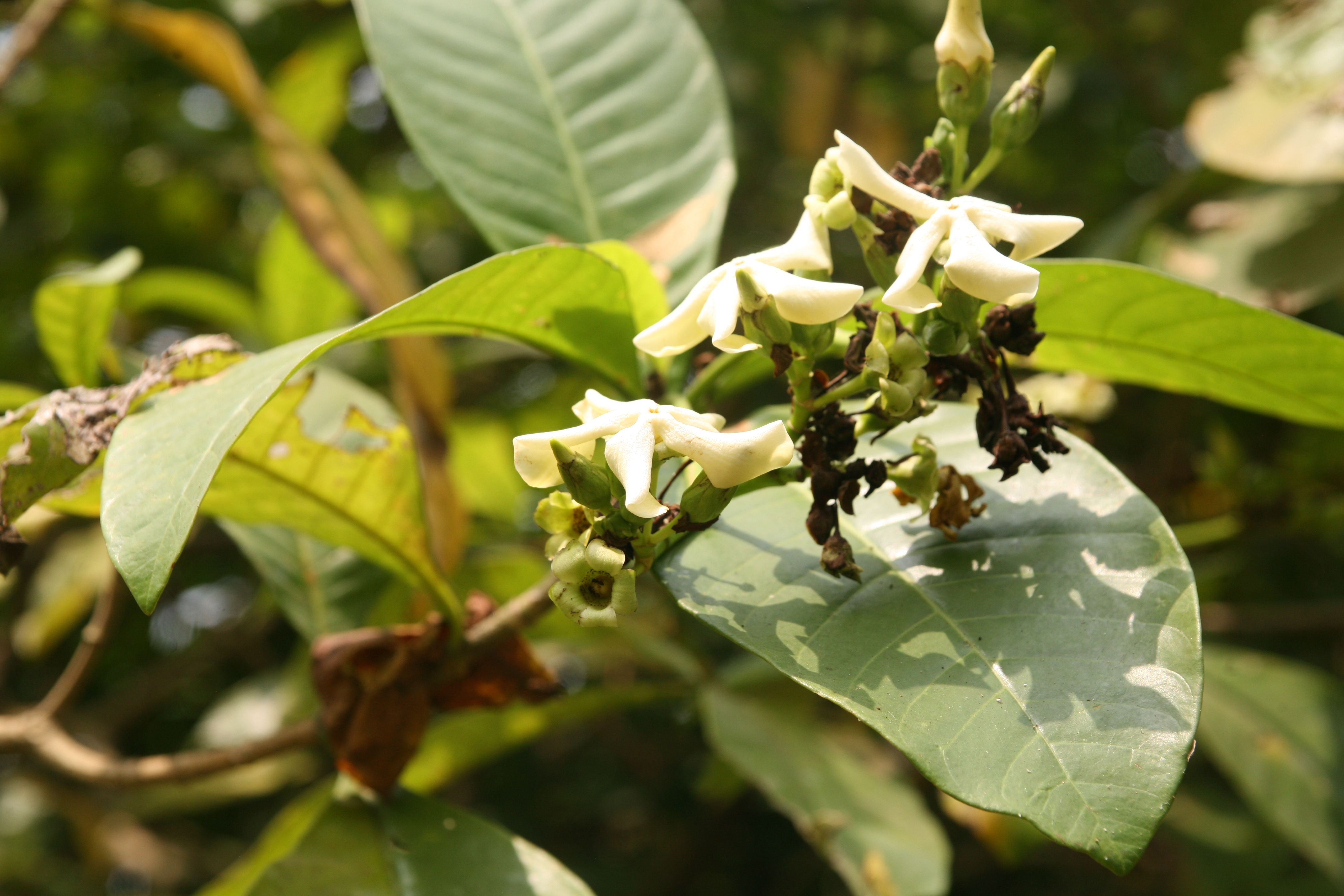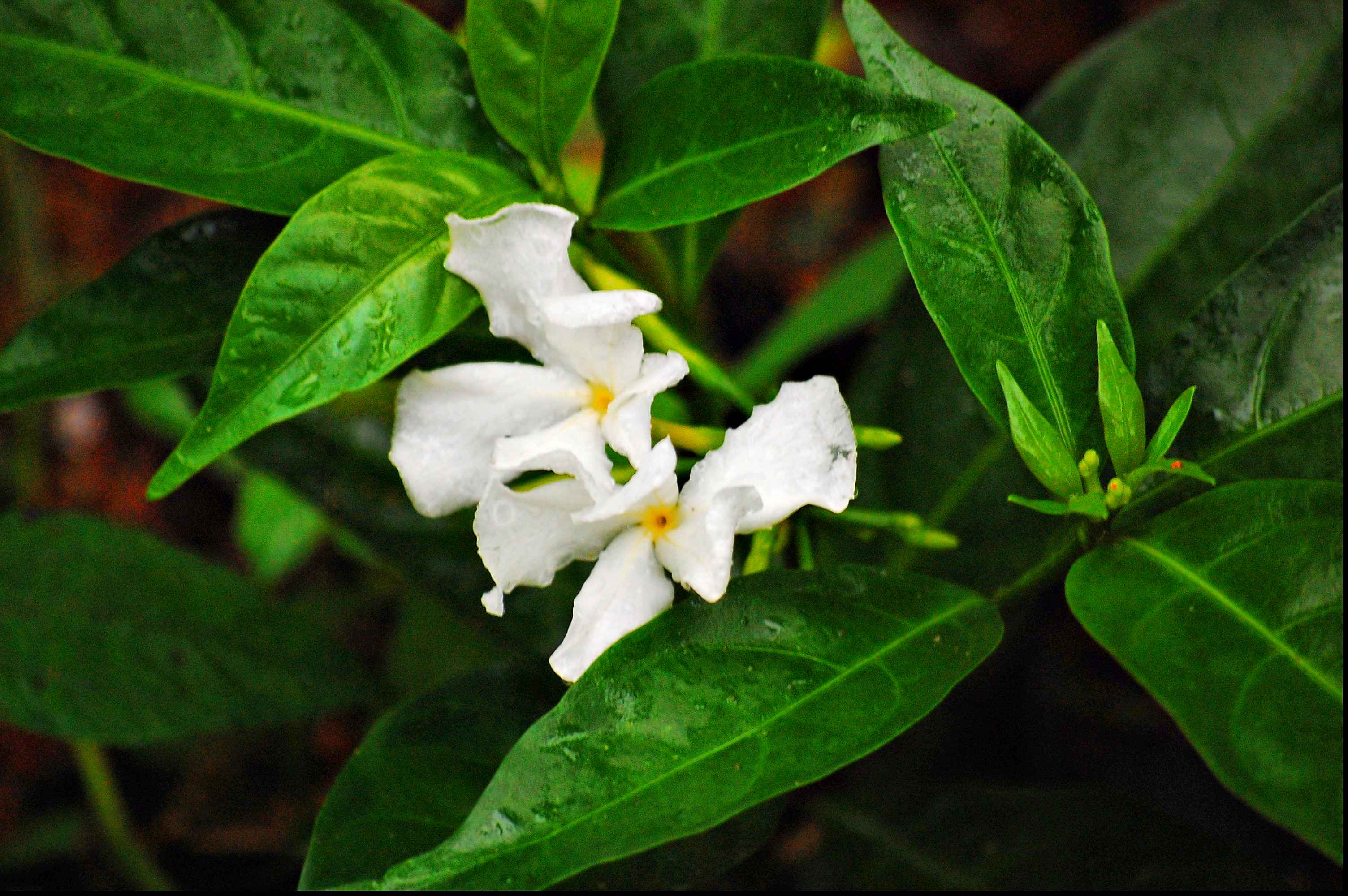|
Vobasine
Vobasine is a naturally occurring monoterpene indole alkaloid found in several species in the genus ''Tabernaemontana'' including ''Tabernaemontana divaricata''. History Vobasine was first reported by Renner in 1959 after its isolation from ''Voacanga africana''. The two structurally related compounds, dregamine and tabernaemontanine, where its alkene (=CHCH3) sidechain was redox, reduced to ethyl groups in two molecular_configuration, configurations, had their relationship confirmed in the 1970s. Vobasine has been found in many plants of the dogbane (Apocynaceae) family including ''Tabernaemontana dichotoma''. Synthesis Biosynthesis As with other Indole alkaloids, the biosynthesis of vobasine starts from the amino acid tryptophan. This is converted into strictosidine before further elaboration. Chemical synthesis The synthesis of alkaloids with the same carbon skeleton as vobasine began in the 1960s and has continued, with some work providing enantioselective synthesis, enantio ... [...More Info...] [...Related Items...] OR: [Wikipedia] [Google] [Baidu] |
Voacristine
Voacristine is a indole alkaloid occurring in '' Voacanga'' and '' Tabernaemontana'' genus. It is also an iboga type alkaloid. Chemistry Its structure is almost similar to voacangine, an alkaloid used in semi-synthesis of ibogaine. Compared to voacangine, it has an extra O-atom. When it is degraded, iboxygaine and ibogaine are formed. Sources Voacristine is found in multiple species of '' Tabernaemontana'' including '' Tabernaemontana divaricata'', '' Tabernaemontana heyneana'', '' Tabernaemontana ventricosa'', and '' Voacanga africana''. See also * Heyneanine * Voacamine * Vobasine References Tryptamine alkaloids {{Alkaloid-stub ... [...More Info...] [...Related Items...] OR: [Wikipedia] [Google] [Baidu] |
Tryptophan
Tryptophan (symbol Trp or W) is an α-amino acid that is used in the biosynthesis of proteins. Tryptophan contains an α-amino group, an α-carboxylic acid group, and a side chain indole, making it a polar molecule with a non-polar aromatic beta carbon substituent. Tryptophan is also a precursor to the neurotransmitter serotonin, the hormone melatonin, and vitamin B3 (niacin). It is encoded by the codon UGG. Like other amino acids, tryptophan is a zwitterion at physiological pH where the amino group is protonated (–; pKa = 9.39) and the carboxylic acid is deprotonated ( –COO−; pKa = 2.38). Humans and many animals cannot synthesize tryptophan: they need to obtain it through their diet, making it an essential amino acid. Tryptophan is named after the digestive enzymes trypsin, which were used in its first isolation from casein proteins. It was assigned the one-letter symbol W based on the double ring being visually suggestive to the bulky letter. Function ... [...More Info...] [...Related Items...] OR: [Wikipedia] [Google] [Baidu] |
Ervaticine
Conolidine is an indole alkaloid. Preliminary reports suggest that it could provide analgesic effects with few of the detrimental side-effects associated with opioids such as morphine, though at present it has only been evaluated in mouse models. Conolidine was first isolated in 2004 from the bark of the ''Tabernaemontana divaricata'' (crape jasmine) shrub which is used in traditional Chinese medicine. The first asymmetric total synthesis of conolidine was developed by Micalizio and coworkers in 2011. This synthetic route allows access to either enantiomer (mirror image) of conolidine via an early enzymatic resolution. Notably, evaluation of the synthetic material resulted in the discovery that both enantiomers of the synthetic compound show analgesic effects. Syntheses The Micalizio route (2011) achieved the end product in 9 steps from a commercially available acetyl-pyridine. Notable reactions include a ,3Still-Wittig rearrangement and a conformationally-controlled in ... [...More Info...] [...Related Items...] OR: [Wikipedia] [Google] [Baidu] |
Hypotensive
Hypotension, also known as low blood pressure, is a cardiovascular condition characterized by abnormally reduced blood pressure. Blood pressure is the force of blood pushing against the walls of the arteries as the heart pumps out blood and is indicated by two numbers, the systolic blood pressure (the top number) and the diastolic blood pressure (the bottom number), which are the maximum and minimum blood pressures within the cardiac cycle, respectively. A systolic blood pressure of less than 90 millimeters of mercury (mmHg) or diastolic of less than 60 mmHg is generally considered to be hypotension. Different numbers apply to children. However, in practice, blood pressure is considered too low only if noticeable symptoms are present. Symptoms may include dizziness, lightheadedness, confusion, feeling tired, weakness, headache, blurred vision, nausea, neck or back pain, an irregular heartbeat or feeling that the heart is skipping beats or fluttering, sweating, and fain ... [...More Info...] [...Related Items...] OR: [Wikipedia] [Google] [Baidu] |
Ethnobotanical
Ethnobotany is an interdisciplinary field at the interface of natural and social sciences that studies the relationships between humans and plants. It focuses on traditional knowledge of how plants are used, managed, and perceived in human societies. Ethnobotany integrates knowledge from botany, anthropology, ecology, and chemistry to study plant-related customs across cultures. Researchers in this field document and analyze how different societies use local flora for various purposes, including medicine, food, religious use, intoxicants, building materials, fuels and clothing. Richard Evans Schultes, often referred to as the "father of ethnobotany", provided an early definition of the discipline: Since Schultes' time, ethnobotany has evolved from primarily documenting traditional plant knowledge to applying this information in modern contexts, particularly in pharmaceutical development. The field now addresses complex issues such as intellectual property rights and equitable ben ... [...More Info...] [...Related Items...] OR: [Wikipedia] [Google] [Baidu] |
Biological Activity
In pharmacology, biological activity or pharmacological activity describes the beneficial or adverse effects of a drug on living matter. When a drug is a complex chemical mixture, this activity is exerted by the substance's active ingredient or pharmacophore but can be modified by the other constituents. Among the various properties of chemical compounds, pharmacological/biological activity plays a crucial role since it suggests uses of the compounds in the medical applications. However, chemical compounds may show some adverse and toxic effects which may prevent their use in medical practice. Biological activity is usually measured by a bioassay and the activity is generally dosage-dependent, which is investigated via dose-response curves. Further, it is common to have effects ranging from beneficial to adverse for one substance when going from low to high doses. Activity depends critically on fulfillment of the ADME criteria. To be an effective drug, a compound not only ... [...More Info...] [...Related Items...] OR: [Wikipedia] [Google] [Baidu] |
Metabolite
In biochemistry, a metabolite is an intermediate or end product of metabolism. The term is usually used for small molecules. Metabolites have various functions, including fuel, structure, signaling, stimulatory and inhibitory effects on enzymes, catalytic activity of their own (usually as a cofactor to an enzyme), defense, and interactions with other organisms (e.g. pigments, odorants, and pheromones). A primary metabolite is directly involved in normal "growth", development, and reproduction. Ethylene exemplifies a primary metabolite produced large-scale by industrial microbiology. A secondary metabolite is not directly involved in those processes, but usually has an important ecological function. Examples include antibiotics and pigments such as resins and terpenes etc. Some antibiotics use primary metabolites as precursors, such as actinomycin, which is created from the primary metabolite tryptophan. Some sugars are metabolites, such as fructose or glucose, which ar ... [...More Info...] [...Related Items...] OR: [Wikipedia] [Google] [Baidu] |
Tabernaemontana Elegans
''Tabernaemontana elegans'', the toad tree, is a shrub or small tree in the family Apocynaceae. It is native to eastern Africa. Description ''Tabernaemontana elegans'' grows up to tall, with a trunk diameter of up to . Its fragrant flowers feature white, creamy or pale yellow corolla lobes. Fruit consists of 2 separate ovoid or ellipsoid pods, up to each. Distribution and habitat ''Tabernaemontana elegans'' grows in forests or bushland from sea level to altitude. The species is native to Somalia, Kenya, Tanzania, Mozambique, Zimbabwe, Eswatini and South Africa. Uses ''Tabernaemontana elegans'' has some local medicinal uses including the treatment of heart disease, cancer, tuberculosis and venereal diseases. The species is also used as an aphrodisiac. The Zulu name for this genus, ''iNomfi'', refers to the use of their sticky, milky latex as bird-lime. Chemistry Fourteen indole alkaloids have been isolated in the callus culture of ''Tabernaemontana elegans'' (isovoacangine, ... [...More Info...] [...Related Items...] OR: [Wikipedia] [Google] [Baidu] |
Tabernaemontana Corymbosa
''Tabernaemontana corymbosa'' is a species of plant in the family Apocynaceae. It is native to Brunei, China, Indonesia, Laos, Malaysia, Myanmar, Singapore, Thailand, and Vietnam. Glossy green leaves and faintly sweet scented flower. Flowers continuously all year. Frost tolerant. Grows to about 2 metres. Likes full sun to part shade. A number of cultivars are available. Chemical composition Multiple compounds of different classes such as Iboga alkaloids and Bisindole alkaloids have been isolated from this plant. Alkaloids such as conodusine A-E, conolodinines A-D, conophylline Conophylline is a autophagy inducing vinca alkaloid found in plants of the genus ''Tabernaemontana''. Among the many functional groups in this molecule is an epoxide: the compound where that ring is replaced with a double bond is called conophylli ..., conophyllinine and taberyunines A-I are present in which many shows antiproliferative and cytotoxic actions. References corymbosa Least concern pl ... [...More Info...] [...Related Items...] OR: [Wikipedia] [Google] [Baidu] |
Voacanga
''Voacanga'' is a genus of plants in the family Apocynaceae found in Africa, Southeast Asia, New Guinea, and Australia. the World Checklist of Selected Plant Families recognises 13 species:Search for "Voacanga", ;Species # ''Voacanga africana'' Stapf ex Scott-Elliot - tropical W + C + E + S Africa # '' Voacanga bracteata'' Stapf - tropical W + C Africa # '' Voacanga caudiflora'' Stapf - tropical W Africa # '' Voacanga chalotiana'' Pierre ex Stapf - tropical C Africa # '' Voacanga foetida'' ( Blume) Rolfe -Java, Borneo, Sumatra, Philippines # '' Voacanga globosa'' (Blanco Blanco (''white'' or ''blank'' in Spanish) or Los Blancos may refer to: People *Blanco (surname) Fictional characters *Blanco, a hobbit in J. R. R. Tolkien's Middle-earth *Blanco Webb, character in the BBC sitcom ''Porridge'' *Graboid#El Blanco, ...) Merr. - Philippines # '' Voacanga gracilipes'' ( Miq.) Markgr. - Maluku # '' Voacanga grandifolia'' (Miq.) Rolfe - Indonesia, Philippines, New Guinea, Que ... [...More Info...] [...Related Items...] OR: [Wikipedia] [Google] [Baidu] |
Genera
Genus (; : genera ) is a taxonomic rank above species and below family as used in the biological classification of living and fossil organisms as well as viruses. In binomial nomenclature, the genus name forms the first part of the binomial species name for each species within the genus. :E.g. '' Panthera leo'' (lion) and '' Panthera onca'' (jaguar) are two species within the genus '' Panthera''. ''Panthera'' is a genus within the family Felidae. The composition of a genus is determined by taxonomists. The standards for genus classification are not strictly codified, so different authorities often produce different classifications for genera. There are some general practices used, however, including the idea that a newly defined genus should fulfill these three criteria to be descriptively useful: # monophyly – all descendants of an ancestral taxon are grouped together (i.e. phylogenetic analysis should clearly demonstrate both monophyly and validity as a separate lineag ... [...More Info...] [...Related Items...] OR: [Wikipedia] [Google] [Baidu] |
Voacanga Africana 06
''Voacanga'' is a genus of plants in the family Apocynaceae found in Africa, Southeast Asia, New Guinea, and Australia. the World Checklist of Selected Plant Families recognises 13 species:Search for "Voacanga", ;Species # ''Voacanga africana'' Stapf ex Scott-Elliot - tropical W + C + E + S Africa # ''Voacanga bracteata'' Stapf - tropical W + C Africa # ''Voacanga caudiflora'' Stapf - tropical W Africa # ''Voacanga chalotiana'' Pierre ex Stapf - tropical C Africa # '' Voacanga foetida'' ( Blume) Rolfe -Java, Borneo, Sumatra, Philippines # ''Voacanga globosa'' (Blanco) Merr. - Philippines # ''Voacanga gracilipes'' ( Miq.) Markgr. - Maluku # ''Voacanga grandifolia'' (Miq.) Rolfe - Indonesia, Philippines, New Guinea, Queensland # ''Voacanga havilandii'' Ridl. - Sarawak # ''Voacanga megacarpa'' Merr. - Philippines # ''Voacanga pachyceras'' Leeuwenb. - Zaïre # ''Voacanga psilocalyx'' Pierre ex Stapf - Nigeria, Cameroon, Gabon, Republic of Congo # ''Voacanga thouarsii'' Roem ... [...More Info...] [...Related Items...] OR: [Wikipedia] [Google] [Baidu] |




